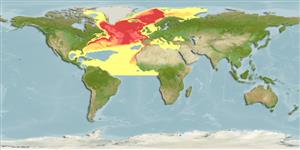Common names from other countries
Environment: milieu / climate zone / depth range / distribution range
Ecología
Pelágico; rango de profundidad 0 - 1453 m (Ref. 122879). Temperate; 90°N - 0°S, 180°W - 180°E
Distribución
Países | Áreas FAO | Ecosistemas | Ocurrencias, apariciones | Introducciones
Atlantic Ocean, Arctic and the Mediterranean. Temperate to Subarctic.
Length at first maturity / Tamaño / Peso / Age
Maturity: Lm ? range ? - ? cm Max length : 980 cm TL macho / no sexado; (Ref. 1394); 870 cm TL (female)
Found in deep waters, mostly seaward of the continental slope. Feeds on squid, fish, sea cucumbers, starfish, and prawns on or near the bottom (Ref. 1394). Maximum depth recorded lasted for 70.5 minutes (Ref. 122879).
Jefferson, T.A., S. Leatherwood and M.A. Webber. 1993. (Ref. 1394)
IUCN Red List Status (Ref. 130435: Version 2024-1)
CITES status (Ref. 108899)
Human uses
Pesquerías: comercial
FAO - pesquerías: landings, species profile | FishSource | Sea Around Us
Herramientas
Más información
Age/SizeCrecimientoLength-weightLength-lengthMorfologíaLarvaAbundancia
Fuentes de Internet
Estimates based on models
Preferred temperature
(Ref.
115969): -0.9 - 4.4, mean 3.2 (based on 712 cells).
Vulnerability
Very high vulnerability (90 of 100).
Price category
Unknown.
